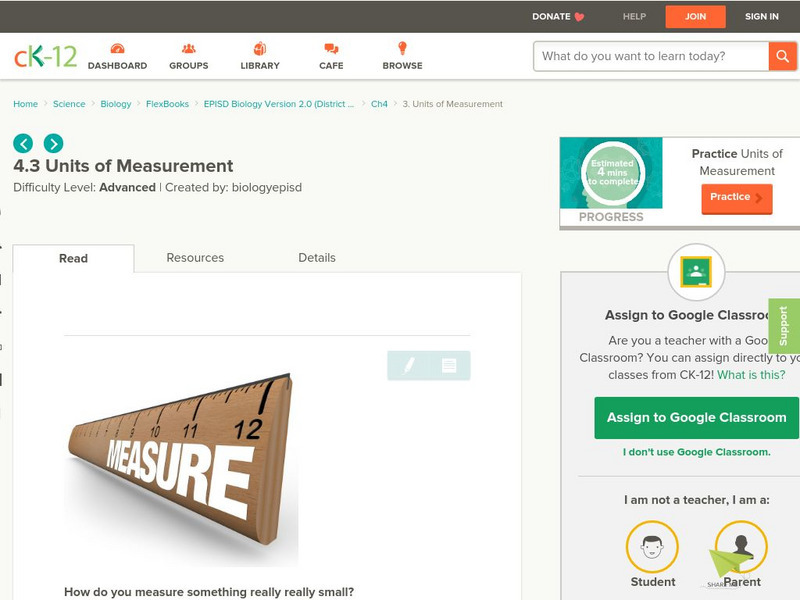Hi, what do you want to do?
Curated OER
Native Plant Restoration Project
Students distinguish between exotic and native plant species. They work in groups in the field to restore a natural habitat. A class map is created to reflect their work in the field.
Curated OER
Cancer City USA
Students investigate a phenomenon known as the cancer cluster. Students determine potential cancer clusters given real data and support their findings using mathematical calculations. Students Create a graphical representation of the...
Curated OER
Rapid Mycological Assessment
Students examine types of mycology methods. They practice using new vocabulary and answer key questions. They complete a field survey and analyze their results.
Curated OER
Superbugs
Students research deep sea communities and discover strategies for combating antimicrobial resistance and write reports on it. They consider overprescription and prophylactic uses of antibiotics as causes for their ineffectiveness.
Curated OER
Primate Classification 2006
Students examine groups of hierarchy and see how primates are categorized. In this primate classification lesson plan students view video and slides then examine the taxonomy of primates.
Curated OER
Toxicology 2: Finding the Toxic Dose
Students brainstorm with group partners to decide upon a chemical they would like to test, and outline a procedure for their investigation. They then present in groups their ideas to the rest of the class as well as the chemical they...
Curated OER
Field Experiments on Succession
Student develop a hypothesis regarding the effects of either mowing or fertilizer upon the diversity of plant species in a grassland ecosystem. They set up experiment field plots and measure species richness.
Curated OER
Addiction As A Disease
Learners study drug addiction and its problem in society. In this addiction lesson students answer questions and complete an activity.
Curated OER
Tying it all Together
Students study an article on drugs in their society. In this investigative lesson students create their own concept map.
Curated OER
Head to Foot
Learners describe the body form and major anatomical structures of squids and describe some unusual or unique features of newly-discovered deep water squid species. They infer what types of food squids use from their anatomical features.
Curated OER
Genome: The Secret of How Life Works
Students become aware that genetic issues impact many areas of life, such as medicine, food and agriculture, and law. They become aware that there are many ethical issues related to genetics.
Curated OER
Growing Plants with Worm Castings
Students test worm castings for content and use them to grow seeds. They hypothesize which castings best sustain seed growth. They observe growing plants to test their hypotheses. Later they graph their data.
Curated OER
Disease, Pandemics, and the Role of Government
Students compare and contrast the global efforts being made to stem a possible avian flu pandemic to the global efforts made to counter the current HIV/AIDS pandemic.
Curated OER
Funeral Rites Research
Learners compare their own cultural/religious beliefs and traditions of death and funerals with those of another culture. They conduct research, and write a research paper.
Curated OER
Earthworms
Fifth graders research the earthworm and write a one paragraph report on its anatomy and habitat. They learn about worms and how to dissect them through Video Streaming and virtual dissections, along with actually dissect a worm as...
Curated OER
Using Yeast as an Ultraviolet Light Measurement Tool
Students accurately measure the relationship between radiation dose and either survival or some genetic event such as mutation or recombination. They investigate the damage that was done to the DNA molecule as a result of exposure to...
Curated OER
Protecting the Herd
Students explain how immunizing a significant proportion of a population against a disease prevents epidemics of the disease (herd immunity). They list factors that affect the proportion of a population that must be immunized to prevent...
Curated OER
Putting on Mass: Just how do Trees grow?
Students articulate an explanation of photosynthesis. They identify problems they have with comprehension of how a plant gains mass. Students describe a historical experiment.
Department of Defense
Do Dea: Biology: Unit 3: Cell Structure
In this third unit of a Biology course, students learn about cells and cell structure. They compare prokaryotic and eukaryotic cells and learn about the specialized structures in a cell and what their functions are. They will also learn...
TeachEngineering
Teach Engineering: Waves: The Three Color Mystery
Students are presented with a challenge question concerning color blindness and asked to use engineering principles to design devices to help people who are color blind. Using the legacy cycle as a model, this unit is comprised of five...
CK-12 Foundation
Ck 12: Units of Measurement
[Free Registration/Login may be required to access all resource tools.] Students will learn how to use standard scientific units of measurement (SI units) in biology.
BiologyWise
Biology Wise: Basic Unit of Life: Plant Cell Structure and Functions
Describes the three types of plant cells and their differences, and the structures within a plant cell and their functions.
Sophia Learning
Sophia: Disaccharides: Lesson 3
This lesson will introduce disaccharides, including an overview of their structure, and providing multiple examples. It is 3 of 4 in the series titled "Disaccharides."
University of California
Regents of the University of California: Amphibia Web
AmphibiaWeb, a site inspired by global amphibian declines, is an online system that allows free access to information on amphibian biology and conservation. This site is filled with amphibian facts, a glossary of terms, species numbers,...




























